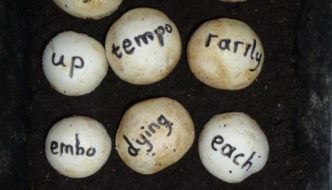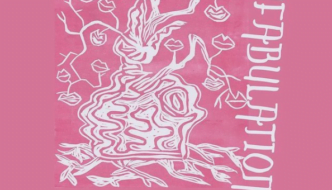An Interview with Glyn Thompson: co-curator of ‘Educating Damien’
January 7, 2015
[All images credited to David Lindsay]
Dan Newton interviews Glyn Thompson, co-curator of Educating Damien* *(and others) and former tutor of Damien Hirst at Jacob Kramer College, Leeds 1983-1984. Read our review of the exhibition (displayed until January 9th)
TSOTA: Educating Damien** (and others): that’s an interesting premise, how did this come about?
GT: The exhibition was prompted by the announcement that a new (ghosted) autobiography of Damien Hirst will be published by Penguin-Viking next autumn. To be written by the author of an earlier mythography of Keith Richard, the prepublication copy printed in the national daily press promised further revelations of Mr Hirst’s alleged criminal exploits in Leeds during his adolescence. Since this subject, and his later investigation for credit fraud, detailed by Gordon Burn, was comprehensively aired in On the Way to Work, one can only await with breathless anticipation further revelations of the youthful indiscretions that Mr Hirst appears keen to celebrate.
Such revelations will, presumably, serve to reinforce the grounding of Mr Hirst’s professional practice in the aesthetics of theft. Mr Hirst is on record as celebrating his practice as an embodiment of Picasso’s alleged dictum that whilst mediocre artist’s borrow, geniuses apparently steal: the conclusion to be drawn from the premises of Mr Hirst’s syllogistic reasoning is that theft guarantees genius, a view upon which the jury appears to be out. He is on record as observing that his generation of artists stole each other’s ideas, and those of others, without compunction, and we look forward to Mr Hirst’s revelation of which ideas other artists stole from him. Mr Hirst has helpfully informed our understanding of this topic by his responses to examples which might otherwise be constructed as plagiarism.
The aim of the exhibition is to ground the promised further mythologisation of Mr Hirst’s early art education in such facts as might be embodied in the material on display at The Tetley.

TSOTA: Do you consider this show at The Tetley to be more about teaching or learning, or a combination of the two?
GT: The exhibition places before the public for the first time curriculum material experienced by Mr Hirst and his cohort, in the hope that it might assist scholars of Mr Hirst’s oeuvre in their understanding of its aesthetic origins.
The exhibition places before the public for the first time curriculum material experienced by Mr Hirst and his cohort, in the hope that it might assist scholars of Mr Hirst’s oeuvre in their understanding of its aesthetic origins.
“…the most important thing that happened to Damien Hirst the artist was his attendance at Jacob Kramer College, evidence of which is on the walls at the Tetley, and obvious to anybody thoroughly familiar with his aesthetic and practice.”
TSOTA: Recently the Secretary of State for Education subtly dismissed the arts as something that you would choose if you didn’t have a clear and focussed future mapped out, and that, today, subjects “that keep young people’s options open and unlock doors to all sorts of careers are the STEM subjects: science, technology, engineering and maths”. What do you think is the value of an art education in today’s society, and how has this changed over the past 20 years or so?
GT: It is clearly lost on the Secretary of State that everything that she wears, owns, consumes and denies others access to, and benefit from, was designed by somebody. This is hardly surprising, given her political inclinations. The woman is a disgrace.
TSOTA: Brian Dillan’s essay ‘Ugly Feelings’ in the Tate Modern’s publication for Hirst’s 2012 retrospective discusses his work under the following headings: shock, curiosity, disgust and hypochondria. How early on during your time with him were these themes evident in his work?
GT: I must confess that Mr Hirst’s attendance at Jacob Kramer failed to induce in myself any symptoms of hypochondria. But whilst being exposed to the tropes cited by Mr Dillon – shock, curiosity, disgust – during the History of Art Lectures delivered by myself, which the material exhibited at The Tetley comprehensively demonstrates, I do not recall any manifestations of them in Mr Hirst’s own work: he is, after all, celebrated in one of the rare references to the Jacob Kramer year in the Tate catalogue as a prospective curtain designer.
There certainly seemed to be no particular manifestation in his work of any interest in the macabre which characterised his alleged drawings made in the University anatomical school morgue before he came to Kramer: it has always struck me as odd that these have never been exhibited, but I understand, from a friend of Mr Hirst, that they might have failed to survive due to his dissatisfaction with their quality, or, rather, lack of it. But his interest in the effects of sensation was, as I recall, illustrated by the most memorable work that he presented for assessment at the end of the Christmas term. This comprised some large ‘colour field’ paintings in brown and red, which appeared to have found their origins outside the curriculum. As in the case of much student work, these were, I think, consigned not – as his work would be later – to the saleroom, but to the dustbin, in the time- honoured manner. But at least their size, and his brass-neck in exhibiting them instead of work produced during the course, ensured they gained attention.
But this exercise was in fact prophetic because, as I recall, during the second part of the course, in the more specialized Fine Art area, on which I taught, Mr Hirst took great pains to remain up to date with the charting of the progress of contemporary art by such international magazines as Art Forum, Art International and so on.
TSOTA: You wrote an interesting article in The Jackdaw discussing myth and actuality, mainly concerning details relating to Hirst’s education in Leeds. Widely considered a provocateur verging on celebrity status, there are many exaggerations, rumours and inaccuracies, surrounding his work. As someone involved in initiating Hirst’s academic pursuit of art, does this frustrate you, or is it just part and parcel of who he is and art/artists in general?
GT: Thank you for the compliment: one tries. I think it is very difficult to identify any specific influence one might have had on any particular individual student, since one’s contact with them represented a very small percentage of their total consciousness of a very stimulating and demanding experience, and Foundation was such an intense experience – one which most ex-students cite as the most important year of their art education, since it acted as a kind of decompression, or rather re-compression chamber between A-level and art and design at Tertiary level. And I think that if any tutor is inclined to burnish their own halo with the future exploits of ex-students, then you are likely to find them among the ranks of the pub-bores. All the distortions you cite seem to me to the product of the mythmaking with which an artist’s own ego is subsequently burnished by themselves and their representatives, acolytes, hangers-on and sycophants – for the obvious reasons.
Some artists, such as Andy Goldsworthy, appear to be quite modest. I’m not sure artists are necessarily congenitally predisposed to be any more susceptible to this than any other group of people; it’s just that once they enter the realm of celebrity it is probably forced upon them. But they do need a certain self-confidence, and even vanity – which is often hard to distinguish from self-belief – which can easily mutate into self-delusion and self-aggrandisement. It certainly strikes me that Mr Hirst has adopted, for whatever reasons, tiresome late-adolescent mannerisms that discourage one from taking him seriously – perhaps deliberately: who knows?

Photo: David Lindsay
TSOTA: What did you consider to be the most challenging aspect of teaching?
GT: Finding the level on which one can actually connect with the conceptual grounding of a student’s understanding. This was much easier in the past when one enjoyed extended personal contact over many months – a privilege and luxury that my generation certainly enjoyed that present students find difficult to comprehend. But as a consequence of my complete experience as a student and tutor, I believe that the atelier system, which used to underpin craft and art training and education, is the best. There is no substitute for working with people who know more about what you are doing than you do yourself, at every stage of your life, and that usually includes people who are younger than yourself.
TSOTA: From a student perspective what would you consider to be a successful approach to art education, and how (if at all) does this differ from pursuing a career in the arts?
GT: I think I’ve just answered that: it applies to all subjects. Art is no different. The problem is, art has, at least in Britain, been considered to be different, in some intangible way, from all other subjects, perhaps because its theorization has been grounded in intuition – in a kind of romanticised Bergsonsian concept of the elan vital – casting the artist in the role of mediumistic being who has no consciousness of what they are doing or how they are doing it. The pernicious effect of Duchamp’s specious nonsense apropos his ‘conception’ of the ‘art coefficient’ is largely responsible for the continued survival and influence of this conceit, which is of course embraced by all artists who believe that they function beyond the judgement of mere mortals, and that their work is justified on the basis that they have produced it, which to them is sufficient explanation: that art is grounded in the choice of the artist. You may wish to read my The Creative Act and The Viewer Completes the Work on this topic.
“… taste is not a good starting point when addressing a work of art, because if you like it, being trapped in an emotional relationship with it, as in love, you cannot interrogate it on a critical or conceptual level, and if you don’t like it, you’ll turn away.”
TSOTA: Can you think of any key moments, experiences or discussions that may have had a direct influence on Hirst’s work?
GT: For the creation of the monstre sacré that we all know and love, enrolling at Goldsmith’s was critical, followed by Charles Saatchi’s patronage. But what was more important was the effect of a change to the constitution of the Turner Prize mechanism, just before 1990. This changed the process whereby an artist could achieve Freud’s rewards of the artist – wealth, Fame and Beautiful Lovers. This meant that instead of waiting until they were dead, having spent their lives in pursuit of aesthetic ideals, and honing their craft, young contemporary British artists were embraced by a mechanism which projected them to El Dorado. Had Hirst been born ten years earlier, he would not have benefited from this mechanism, and we would not be talking to each other about him. (I could give you an analysis of it, if you like – but not written: you don’t get owt for nowt in Damien Hirst’s Yorkshire.). But the most important thing that happened to Damien Hirst the artist was his attendance at Jacob Kramer College, evidence of which is on the walls at the Tetley, and obvious to anybody thoroughly familiar with his aesthetic and practice.
TSOTA: Do you like how his work (and/or fame) has progressed?
GT: Whether I like it or not is irrelevant, since it wasn’t made for my consumption. As Turner said, in riposte to a confidence given on varnishing day, at the R.A., that the committee didn’t like his Snowstorm at Sea, “‘They had no business liking it”. In order to understand a work of art you must re-inscribe it in the discourse from which it emanated and which it embodies in the form of its expression. This means that you must identify the specific audience for whose consumption and understanding the work was created.Anything else is cultural tourism. For example, whether you like it or not, Michelangelo’s Sistene Ceiling was not created for the edification of me, or you, or Muslim market gardeners, even if God might have created parsnips on the third day. There is a common misunderstanding that there is a causal link between quality in art and success in art. But such a link has yet to be demonstrated, since the conditions within which the one is produced are not the same as those in which the other is. The assumption of the role of such a link leads to such questions as ‘How come, if it’s so crap, is he so successful’. Only by separating them can you begin you understand both.

Photo: David Lindsay
I have found, in my career as an art historian – of sorts – that the more I understand a work of art, the better I like it. I have also come to the conclusion that taste is not a good starting point when addressing a work of art, because if you like it, being trapped in an emotional relationship with it, as in love, you cannot interrogate it on a critical or conceptual level, and if you don’t like it, you’ll turn away. In my experience, therefore, love is never enough: lust is a better emotional state in which to address a work of art. As Baudelaire said,: “Enivrez-vous”: ‘stay intoxicated (on anything) – but stay intoxicated’.
TSOTA: How many of your ideas did he steal?(!)
GT: I can’t imagine he ‘stole’ anything, on the basis that before you steal a minaret, you must first dig a well: what he received was freely given to all the students. (The fact that this is the meaning of the word ‘Eucharist’ has some bearing on the matter in hand.). That was how education was then. But what I do think – to reiterate a point made earlier – is that what I showed to his cohort, and what I said, and recommended, to them, – has become manifested very specifically in Damien Hirst’s mature aesthetic, practice and oeuvre, whether he was or is conscious of it or not –: and I believe the exhibition at the Tetley demonstrates this. And I am not alone.
Educating Damien* *and others (14th November 2014 – 9th January 2015) is supported by Arts Council England, Leeds City Council, Wild Pansy Press, The University of Leeds, Leeds Museums and Galleries and Artforms Artemis.




Comments